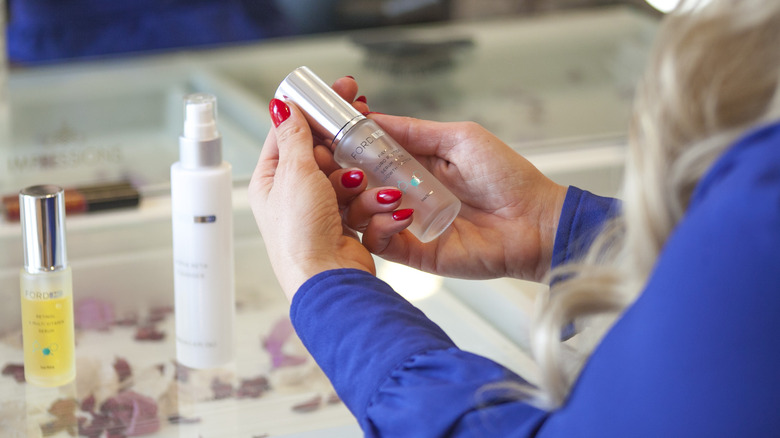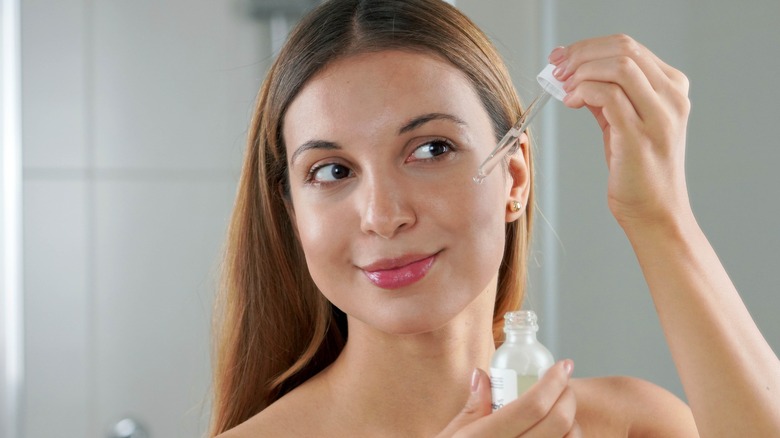Can You Mix Retinol And Enzymes Together In Your Skincare Routine?
From citrus oils to glycerin, there are many potent ingredients against aging skin. However, retinol is something else. An antioxidant derived from vitamin A, over-the-counter retinol has been clinically proven to effectively reduce aging lines by boosting skin cell production. According to a 2015 study published in the Journal of Cosmetic Dermatology, topical use of retinol has a positive impact on the cellular and molecular properties of the outermost layer of the skin and the inner layer of the skin, contributing to reduced facial wrinkles within one month after treatment.
A new powerhouse ingredient that's hitting fever pitch in the anti-aging skincare aisle is enzymes — a protein that's responsible for a myriad of biological processes in our bodies. Without a steady dose of enzymes, the skin cannot be in its tip-top shape. Adding enzymes to a product amplifies its effects on the skin. Most enzymes used in skincare products are derived from natural sources such as bromelain and papain. What they do is to break down the keratin protein in the upper layer of the skin to enable easy removal of dead skin cells, resulting in smoother skin and diminished pigmentation, skin-fluencer and photographer Emma Hoareau tells Byrdie.
So, retinol is all about supporting healthy cell turnover, while enzymes can improve skin texture and brighten complexion. Can they make each other's one true pairing in the same skincare routine? Here's what we know so far.
Retinol and enzymes do not mix
There's an ancient Chinese proverb that goes, "One mountain cannot have two tigers." What this saying means is that two things or people that are too strong by themselves cannot coexist in the same place. Such is the case of retinol and enzymes. These two potent ingredients are not a match made in skincare heaven.
Like acids, fruit enzymes also exfoliate the skin to unclog pores and reveal a new layer of healthier skin. When acids like AHAs and BHAs mix with retinol, the combination can lead to dryness and irritation in the skin. That's why most dermatologists would advise against using AHAs or BHAs in the same routine with retinol. Although fruit enzymes are more gentle an exfoliation than acids, they can also trigger an adverse reaction when mixed with retinol. "Enzymes can be used instead of other exfoliators, but using them at the same time as retinol might lead to potential for peeling or inflammation," dermatologist Dr. Alicia Zalka tells Byrdie. "I suggest not using these in combination on the same application or same day, unless advised by a trusted skin care professional or if your skin is at baseline, oily, and highly tolerant."
How to use enzymes on your skin
When it comes to using enzymes in skincare, exfoliating masks, peels, and cleansers are some of the most recommended methods. In contrast to more aggressive chemical forms of exfoliation, enzyme exfoliation has proved to be a gentler technique to slough away dead skin cells and brighten the skin, making it tolerable for those with sensitive skin. Usually, an enzyme peel or mask is applied after a face wash. After putting on the mask, leave it on for about one minute, rinse thoroughly, and follow with a serum or moisturizer of your choice.
"Most enzyme-containing products are designed to be applied for a period of time, not to be left on the skin all day," cautions dermatologist Dr. Alicia Zalka. That's why products based on enzymes are not suitable for use as leave-on moisturizers. For those with acne problems, enzymes might not be of much help. The reason being is they cannot loosen and dissolve keratin to penetrate the skin as well as AHAs and BHAs, notes Dr. Zalka.
Also, enzymes have a short shelf life. To preserve their quality and extend their shelf life, take care to keep them in a cool and dry place like a mini skincare fridge, suggests dermatologist Dr. Harold Lancer.


